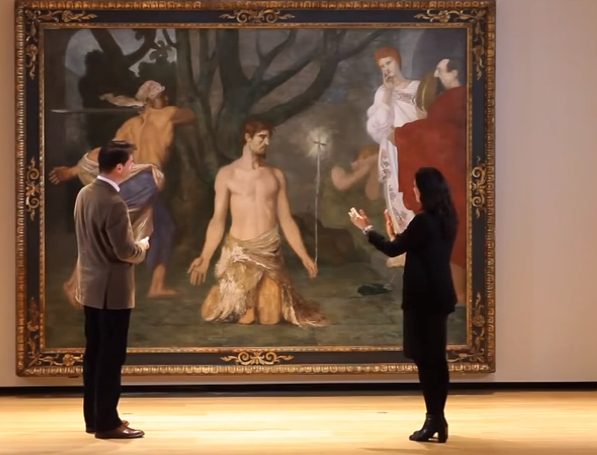This conversation between Dr. Jennifer Sliwka and theology professor Ben Quash surrounding the stature of St John the Baptist in the history of art and christian iconography is truly fascinating. Something that was new to me was new to me was how medieval and early renaissance artists presented the prophet as a teenager emerging into the wilderness, As I was watching these videos, apart by being in state of awe, I also couldn’t help noticing how nicely its shot on DSLR video, and thus, giving its production a much more film-like and candid appeal. Art history has never been boring, and I enjoy how this material is presented. Watching these videos also reminded me how mass media forces us to look quickly at things, whether as painting forces us to slow down and digest our vision.
La conversación que rodea la figura de San Juan Bautista en la historia del arte y la iconografía cristiana que surge entre una historiadora del arte, como la Dra. Jennfer Sliwka y el Profesor de Teologia Ben Quash es realmente fascinante.
Algo novedoso para mi fue descubrir como al profeta lo representaban como un joven adolecen dejándolo todo para sumergieres en la naturaleza; estos videos son una maravilla, tanto por el contenido que transmiten como por la manera en que han sido producidos usando cámaras de 35mm, also que a mi parecer hace del contenido mas gustoso y fácil de digerir pues comunica una sensación de candidez. La historia del arte jamas ha sido aburrida, y al ver estos videos recuerdo el como los medios de acceso masivo nos obliga a ver cosas demasiado rápido, la pintura, por su parte, nos fuerza a detenernos y digerir las cosas que encuentran los ojos.
Episode 1: Introduction
It’s amazing how St. John the baptist is presented as a strong, alienated character on Crivelli’s Altarpiece. I really liked how the artist painted the veins on the figure, giving the saint a rebellious, uncompromising appearance. La manera en que Crivelli ilustra la imagen de Juan Bautista en esta pieza de altar es algo que me parece bien particular, las venas en la figura del profeta proyectan una imagen de rebeldia que llama poderosamente la atención.
Episode 2: Visitation
It's intriguing to imagine how Saganelli combined both stories in one single composition. It reminds me of how when on film or literature, an specific character (Elizabeth) leads another character (Mary) indicating about what's to come.
Me parece curioso como Saganello combino ambos pasajes biblicos en una misma composición. Me recuerda a esas escenas del cine o la literatura en que un personaje, en este caso Isabel, guía otro personaje como Maria enseñándole lo que ha de pasar en el futuro.
Episode 3
Episode 4
I really liked how Bronzino depicted infant Jesus, it almost resembles a snap shot captured at the right moment El modo en que Bronzinio ilustra la figura del Niño Jesus le da una apariencia a la obra basante natural, casi parece una instantanea tomada en el momento justo.
Episode 5
John the Baptist presented as a teenager, entering the wilderness is a real cool idea, I don’t recall ever seen it before. Juan el Bautista pintado como un joven dejando la sociedad para internarse en la naturaleza es bastante peculiar, no recuerdo haber visto antes esta idea plasmada en una pintura
Episode 6: Preaching
One subject matter, and multiple directions to reach the idea. La misma historia narrada desde diferentes ángulos.
Episode 7: Baptism
Water sculpture, contrast between light and dark to create depth (small painting) Piero de la francesca, design, simple execution
Episode 8:Martyrdom
Caravaggio’s painting shows the process of the beheading, as it’s happening. chavanne’s scale, theatrical effect
Episode 9: The Baptist’s Head
Caravaggio’s life size, cropped composition. Salome’s expression looking out of the picture. Ana Maria Pacheco
Episode 10: Power and Judgement
kings. christian kings.
